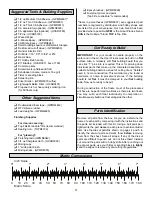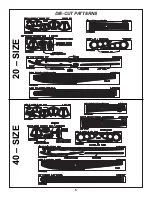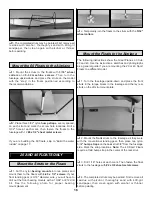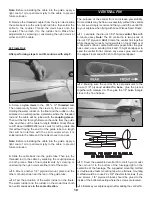
❏
2. Mix up 1 oz. of finishing resin following the
instructions provided in the Great Planes Pro
™
Epoxy
Finishing Resin kit. Use an epoxy brush to liberally coat the
transom of the float.
❏
3. Place the cloth on the resin-coated transom, then
brush the resin through the cloth, removing excess resin
from the center to the edges. Be sure to allow the excess
glass cloth to wrap around the top, sides and bottom of the
float. Some expert modelers squeegee the excess resin off
with a business card or expired plastic credit card. Let the
transom fully cure. Then with a sanding block and fresh 220
grit sandpaper, feather the glass cloth into the float top,
sides and bottom.
❏
4. Apply glass cloth and resin to the deck and sides (one
piece). The cloth should wrap around the bottom 1/4". Hint:
If you cut and position the cloth with the weave running at
45 degrees to the float, the cloth will more readily go
around the sharp bottom corners. Try it!
Another Hint: Build a simple stand to hold the float while you
apply the resin and cloth to the deck and sides. Let the deck
and sides fully cure. Then with a sanding block and fresh 220
grit sandpaper, feather the glass cloth into the bottoms.
❏
5. Following the same procedure outlined above, apply
glass cloth to the bottoms and step. The cloth needs to
overlap the sides 1/4" as shown in the sketch.
❏
6. Lightly sand the entire float with 320-grit sandpaper
being careful not to cut into the glass cloth. Mix up a
2 oz. batch of resin and use a regular camel hair or similar
1" wide paint brush to brush on another coat of resin over
the entire float. For ease of handling, you may do the top
and sides first, then the bottom. If you work quickly you can
save the paint brush by cleaning it with alcohol before the
resin begins to thicken.
❏
7. Carefully sand the entire float with 360-grit sandpaper
and a sanding block, being careful not to sand through
to the cloth. Note: See step 2 under Pushrod Hookup on
page 17 and glue the 1/8" plywood mount block to the deck
after you apply the glass cloth. It is not necessary to cover
the mount block with glass cloth but you should apply resin
over the bare wood. The float is now ready for a coat of
primer. If you have sanded through the second coat of resin
into the cloth, you will have to apply a third coat of resin in
those areas.
❏
8. Apply a coat of primer to the floats. Many expert
modelers have established their favorite brand of paint and
painting methods, but our recommendation is Top Flite
LustreKote Primer. Over glass cloth and resin, one coat of
primer may be sufficient but two coats may be required. You
may dry sand between coats of primer and paint but wet
sanding is preferred – be sure to plug the holes in the deck
for the strut mounts so water does not get inside and do
not sand through the glass cloth.
❏
9. Paint the floats. Again, our recommendation is Top
Flite LustreKote. If you have a good base coat of primer you
may need only one coat of color.
Before you continue, take a break from building and
study the following information to be sure you
understand the positioning of the floats in relation to
the wing and fuselage.
While the following instructions show the Sport Floats on
Great Planes Piper Cubs, there are general tips and
guidelines that apply to all models which will insure proper
handling characteristics in the water and good landing and
takeoff tendencies.
POSITIONING OF FLOATS
12
Содержание Sport Floats
Страница 4: ...4 DIE CUT PATTERNS 60 SIZE...
Страница 5: ...5 DIE CUT PATTERNS 20 SIZE 40 SIZE...
Страница 21: ......





















